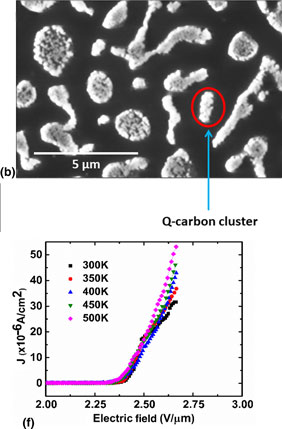Crossref Citations
This article has been cited by the following publications. This list is generated based on data provided by
Crossref.
Haque, Ariful
Mahbub, Ahmed R.
Abdullah-Al Mamun, Md
Reaz, Mahmud
and
Ghosh, K.
2019.
Fabrication and thickness-dependent magnetic studies of tunable multiferroic heterostructures (CFO/LSMO/LAO).
Applied Physics A,
Vol. 125,
Issue. 5,
Zkria, Abdelrahman
Haque, Ariful
Egiza, Mohamed
Abubakr, Eslam
Murasawa, Koki
Yoshitake, Tsuyoshi
and
Narayan, Jagdish
2019.
Laser-induced structure transition of diamond-like carbon coated on cemented carbide and formation of reduced graphene oxide.
MRS Communications,
Vol. 9,
Issue. 3,
p.
910.
Narayan, J.
Bhaumik, A.
and
Haque, A.
2019.
Pseudo-topotactic growth of diamond nanofibers.
Acta Materialia,
Vol. 178,
Issue. ,
p.
179.
Haque, Ariful
Sachan, Ritesh
and
Narayan, Jagdish
2019.
Synthesis of diamond nanostructures from carbon nanotube and formation of diamond-CNT hybrid structures.
Carbon,
Vol. 150,
Issue. ,
p.
388.
Shen, Yan
Han, Yuchen
Zhan, Runze
Zhao, Peng
Zhang, Yu
Liu, Fei
Chen, Jun
She, Juncong
Xu, Ningsheng
and
Deng, Shaozhi
2020.
Study on Pyramidal Molybdenum Nanostructures Cold Cathode with Large-Current Properties Based on Self-Assembly Growth Method.
ACS Applied Materials & Interfaces,
Vol. 12,
Issue. 31,
p.
35354.
Zhang, Zesheng
Chen, Long
Deng, Jun
Wang, Guobin
Song, Yanpeng
Guo, Jiangang
Wang, Wenjun
and
Chen, Xiaolong
2020.
Intrinsic ferromagnetism in 4H-SiC single crystal induced by Al-doping.
Applied Physics A,
Vol. 126,
Issue. 9,
Huran, Jozef
Balalykin, Nikolay I.
Sasinková, Vlasta
Kleinová, Angela
Nozdrin, Mikhail A.
Kobzev, Alexander P.
and
Kováčová, Eva
2020.
Very thin N-doped nanostructured carbon films on quartz and sapphire substrate: Photoelectron emission properties.
Thin Solid Films,
Vol. 709,
Issue. ,
p.
138200.
Gabdullin, Pavel
Zhurkin, Alexey
Osipov, Vasiliy
Besedina, Nadezhda
Kvashenkina, Olga
and
Arkhipov, Alexander
2020.
Thin carbon films: Correlation between morphology and field-emission capability.
Diamond and Related Materials,
Vol. 105,
Issue. ,
p.
107805.
Yoshinaka, Hiroki
Inubushi, Seiko
Wakita, Takanori
Yokoya, Takayoshi
and
Muraoka, Yuji
2020.
Formation of Q-carbon by adjusting sp3 content in diamond-like carbon films and laser energy density of pulsed laser annealing.
Carbon,
Vol. 167,
Issue. ,
p.
504.
Haque, Ariful
and
Narayan, Jagdish
2020.
Conversion of h-BN into c-BN for tuning optoelectronic properties.
Materials Advances,
Vol. 1,
Issue. 4,
p.
830.
Manomaisantiphap, Siwat
Kumar, Vipin
Okada, Takao
and
Yokozeki, Tomohiro
2020.
Electrically conductive carbon fiber layers as lightning strike protection for non-conductive epoxy-based CFRP substrate.
Journal of Composite Materials,
Vol. 54,
Issue. 29,
p.
4547.
Larsson, Karin
2020.
The Combined Influence of Dopant Species and Surface Termination on the Electronic Properties of Diamond Surfaces.
C,
Vol. 6,
Issue. 2,
p.
22.
Haque, Ariful
Gupta, Siddharth
and
Narayan, Jagdish
2020.
Characteristics of Diamond Deposition on Al2O3, Diamond-like Carbon, and Q-Carbon.
ACS Applied Electronic Materials,
Vol. 2,
Issue. 5,
p.
1323.
Joshi, Pratik
Haque, Ariful
Gupta, Siddharth
Narayan, Roger J.
and
Narayan, Jagdish
2021.
Synthesis of multifunctional microdiamonds on stainless steel substrates by chemical vapor deposition.
Carbon,
Vol. 171,
Issue. ,
p.
739.
Haque, Ariful
and
Narayan, Jagdish
2021.
Tunable n-Type Conductivity and Transport Properties of Cubic Boron Nitride via Carbon Doping.
ACS Applied Electronic Materials,
Vol. 3,
Issue. 3,
p.
1359.
Khosla, Nayna
and
Narayan, Jagdish
2022.
Fabrication of Q-Carbon Nanostructures, Diamond and Their Composites with Wafer-Scale Integration.
Crystals,
Vol. 12,
Issue. 5,
p.
615.
Haque, Ariful
Karmakar, Subrata
Trivedi, Ravi Kumar
Chakraborty, Brahmananda
and
Droopad, Ravi
2023.
Electric-Field Emission Mechanism in Q-Carbon Field Emitters.
ACS Omega,
Vol. 8,
Issue. 10,
p.
9307.
Karmakar, Subrata
Taqy, Saif
Droopad, Ravi
Trivedi, Ravi Kumar
Chakraborty, Brahmananda
and
Haque, Ariful
2023.
Highly Stable Electrochemical Supercapacitor Performance of Self-Assembled Ferromagnetic Q-Carbon.
ACS Applied Materials & Interfaces,
Vol. 15,
Issue. 6,
p.
8305.
Taqy, Saif
Sarkar, Pallab
Hamid, Md Abdul
Pranto, Tarik
Piner, Edwin L.
Droopad, Ravi
and
Haque, Ariful
2024.
Diamond deposition on AlN using Q-carbon interlayer through overcoming the substrate limitations.
Carbon,
Vol. 219,
Issue. ,
p.
118809.




